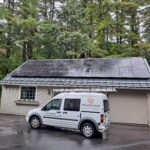Systems generating electric current from energy in the sun’s rays are referred to as photovoltaic (PV for short) or solar electric. They are sometimes confused with solar thermal systems because they look similar and are often mounted on roofs of homes, sometimes even integrated together into what appears to be a single array.
Solar Electric
A solar electric system creates electricity which can be used by the electric loads in your home. Solar electric systems can create electricity thanks to the photovoltaic effect. When the sun strikes the silicon PV cells, electrons are excited and want to get on the move. The wiring of the PV array corrals these electrons and marches them to the inverter, where the combined current is converted to AC and sent to the appliances in your home or back to the power grid. PV modules are flat, glass-encased panels that often have a shiny bluish or black appearance. Typical solar electric systems combine 15 to 35 of these modules into an array.
Solar Thermal
A solar thermal system uses energy from the sun to heat water used in a home or pool, or for heating the home itself.
Solar thermal collectors look very similar to PV modules – they are both flat panels roughly 3′ by 5′ in size. Solar thermal collectors do not have the shiny appearance of PV modules, which is one way to tell them apart. Another telltale sign is the presence of plumbing, rather than wiring (which you usually can’t see from the ground anyway), leading from the panels.
A solar thermal system is a closed-loop system where a liquid such as glycol circulates through the collector on the roof. As it does, the sun is beating down on the collector and warming the liquid flowing through it. The heated liquid then travels to the home’s hot water heater and transfers its heat energy to the water in the heater. This is basically heating the water for free, rather than paying for electricity or gas to heat up the water. (Instead of your water heater, the heated liquid could be used in a similar way to heat your swimming pool.)
Both solar electric and solar thermal are excellent means of harnessing some of that free power from the sun, and both are eligible for generous rebates. Homeowners should work with an experienced local installer, such as Brightstar Solar, who can tell them if you have a good site for solar and which solar technology (solar electric or solar thermal) would be best for their site. Call 617-564-0050 or contact us for a free solar evaluation of your home.








Pingback: Tweets that mention Solar Thermal vs. Solar Electric — BRIGHTSTAR SOLAR -- Topsy.com
Pingback: Connecticut Increases Solar Thermal Incentives by 60% — BRIGHTSTAR SOLAR
Can you be more specific about the content of your article? After reading it, I still have some doubts. Hope you can help me.
May I just say what a relief to discover somebody that really knows what they
are discussing on the internet. You actually realize how to
bring a problem to light and make it important. More people should check this out and
understand this side of your story. It’s surprising you are not more popular given that you most
certainly possess the gift.
My blog: nordvpn coupons inspiresensation
Good answers in return of this query with genuine arguments and telling
all about that.
Feel free to surf to my web page – nordvpn coupons inspiresensation [t.co]
Your style is really unique compared to other folks
I’ve read stuff from. Many thanks for posting when you have the opportunity, Guess I will just bookmark this web site.
my page … nordvpn coupons inspiresensation
350fairfax nordvpn discount
I like the helpful info you provide to your articles.
I will bookmark your weblog and test again here frequently.
I’m fairly sure I’ll learn a lot of new stuff right here!
Best of luck for the next!